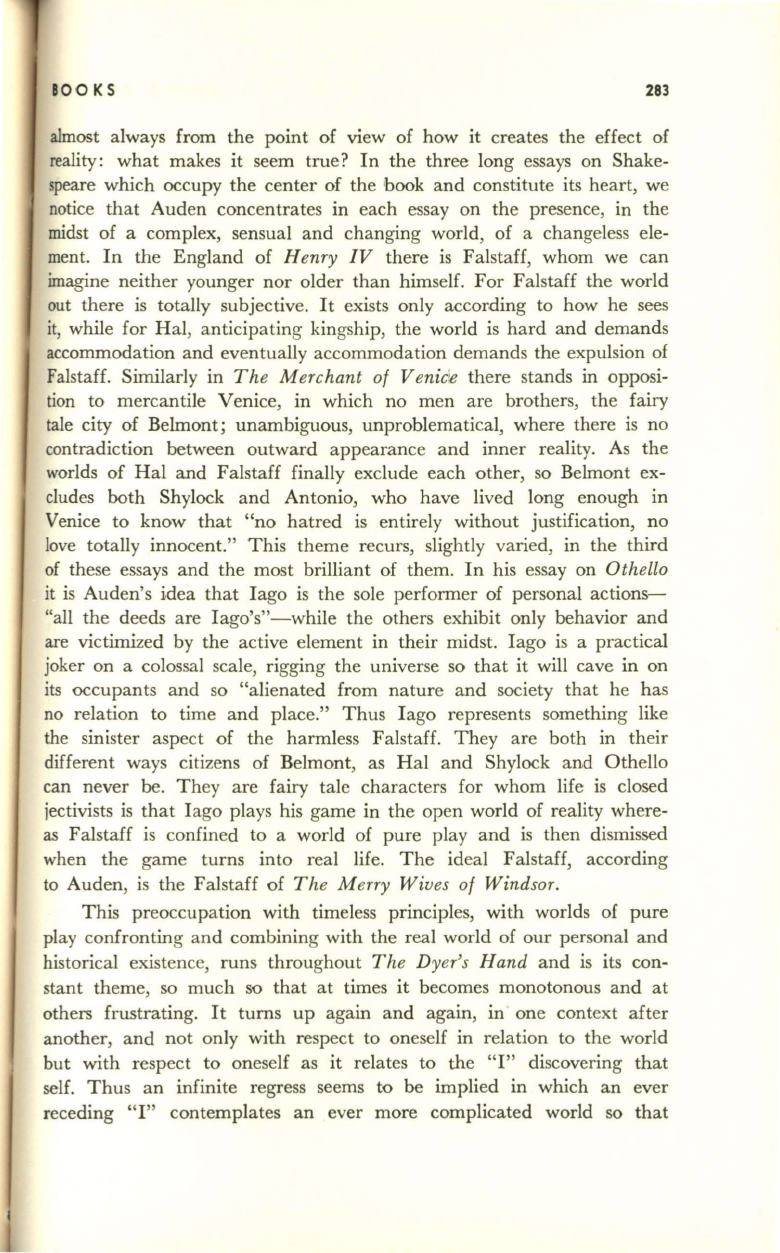
100 KS
283
almost always from the point of view of how it creates the effect of
reality: what makes it seem true? In the three long essays on Shake–
speare which occupy the center of the book and constitute its heart, we
notice that Auden concentrates in each essay on the presence, in the
midst of a complex, sensual and changing world, of a changeless ele–
ment. In the England of
Henry IV
there is Falstaff, whom we can
imagine neither younger nor older than himself. For Falstaff the world
out there is totally subjective. It exists only according to how he sees
it, while for Hal, anticipating kingship, the world is hard and demands
accommodation and eventually accommodation demands the expulsion of
Falstaff. Similarly in
The Merchant of Venicie
there stands in opposi–
tion to mercantile Venice, in which no men are brothers, the fairy
tale city of Belmont; unambiguous, unproblematical, where there is no
contradiction between outward appearance and inner reality. As the
worlds of Hal and Falstaff finally exclude each other, so Belmont ex–
cludes both Shylock and Antonio, who have lived long enough in
Venice to know that "no hatred is entirely without justification, no
love totally innocent." This theme recurs, slightly varied, in the third
of these essays and the most brilliant of them. In his essay on
Othello
it is Auden's idea that Iago is the sole performer of personal actions–
"all the deeds are !ago's"-while the others exhibit only behavior and
are victimized by the active element in their midst. Iago is a practical
joker on a colossal scale, rigging the universe so that it will cave in on
its occupants and so "alienated from nature and society that he has
no relation to time and place." Thus Iago represents something like
the sinister aspect of the harmless Falstaff. They are both in their
different ways citizens of Belmont, as Hal and Shylock and Othello
can never be. They are fairy tale characters for whom life is closed
jectivists is that !ago plays his game in the open world of reality where–
as Falstaff is confined to a world of pure play and is then dismissed
when the game turns into real life. The ideal Falstaff, according
to Auden, is the Falstaff of
The Merry Wives of Windsor.
This preoccupation with timeless principles, with worlds of pure
play confronting and combining with the real world of our personal and
historical existence, runs throughout
The Dyer's Hand
and is its con–
stant theme, so much so that at times it becomes monotonous and at
others frustrating. It turns up again and again, in one context after
another, and not only with respect to oneself in relation to the world
but with respect to oneself as it relates to the "I" discovering that
self. Thus an infinite regress seems to be implied in which an ever
receding "I" contemplates an ever more complicated world so that


